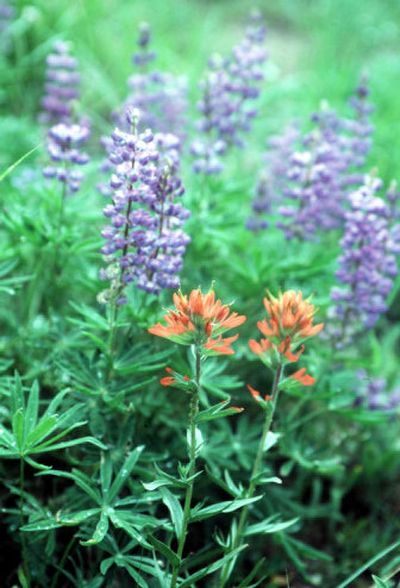Wild about flowers?

Finding wildflowers can be as simple as stepping into the woods.
But learning about these sometimes delicate and often brilliant plants can add a layer of fun and interest to spring and summer outings.
They grow almost anywhere the land is untilled and undeveloped. They can be found in lush meadows, in the shade of dense forests, along roadsides and trails. They pop up on mountaintops, in deep ravines and sometimes in crevices of rocks where there is only a pinch of soil.
Some species, such as Indian paintbrush, are familiar to most people and can be identified from a fast-moving car. Others, like the mountain lady’s slipper orchid, are rare and take some sleuthing and ground pounding to find. And some, like MacFarlane’s four-o’clock, are even protected by the Endangered Species Act.
North central Idaho and Eastern Washington are loaded with prime wildflower habitat.
“Pretty much just drive a couple of hours east from Lewiston, get out of the car and you are in a great spot,” says Matt Parks, associate curator of the University of Idaho Stillinger Herbarium at Moscow.
“Anywhere up the Lochsa and Selway this time of year should be very, very beautiful and there are plenty of hiking trails up through there.”
Other popular wildflower spots include Kamiak Butte near Pullman, Idlers Rest near Moscow, Craig Mountain south of Lewiston or Elk Creek Falls near Elk River. Or, as Parks says, just drive to a national forest or any piece of public land and start looking.
Many but not all of the spring blooms have already come and gone at low elevations. Wildflowers are like that — here one day and gone just a few days or weeks later.
“They are really pretty ephemeral. They last just a short period of time,” Parks says.
But if you missed them here all you need to do is go up in elevation. Wildflowers bloom from early spring through July depending on elevation.
“The early flowers, the skunk cabbage over here, blooms at the end of March or the middle of March,” says Mark Turner, of Bellingham, a photographer and author of “Wild Flowers of the Pacific Northwest.” “For the alpine stuff they don’t really get going until the third or fourth weeks of July, and by mid-August they are pretty much done because you may be getting snow again.”
If you miss a particular flower at lower elevations you probably haven’t missed it all together. It’s all a matter of elevation.
“As you go up you kind of go back in the season,” Turner says.
Some avid wildflower fans plan special trips to look for and take pictures of their favorite species. But many people are drawn to the showy plants while hiking, camping, rafting or fishing.
“I think for most of the public going out and finding plants specifically isn’t their main goal,” Parks says. “They are more interested in being out but it’s kind of nice to know what all these beautiful plants are they are seeing.”
A good way to learn about the plants is to pack along a wildflower field guide. Turner’s book was recently published by Timber Press. Other popular guides include “Wayside Wildflowers of the Pacific Northwest” by Dee Strickler, “Plants of the Lewis and Clark Expedition” by Wayne Phillips, and “Rocky Mountain Wildflowers” by Jerry Pavia.
Finding the plants in the pages of books and learning the names and other facts can be as fun as finding them in the wild. The common names are sometimes as colorful as the flowers.
The shooting star, for example, has dart-shaped flowers with pink or purple petals that fade to white and then bright yellow before coming together in a dark tip.
Flowers of the sage brush, leafy and mountain bluebells grow in clumps, are blue to violet and from the right perspective look like tiny bells.
The flowers of prairie smoke look more like abstract bells or alien heads then smoke until they reach full bloom, open and display clumps of long wispy hair.
When they occur in large clusters the hairs can appear like smoke hovering above the ground.
The mountain lady’s slipper orchid has a large white pouch with purple stripes, a brilliant yellow flower and long purple leaves.
Those who go deeper will learn there are several species of or variations of popular wildflowers. Most people see red when they think about Indian paint brush. But there are more than 200 species of Indian paint brush in several colors, including yellow, purple and white.
Once wildflowers are found, experts like Parks would prefer people take pictures and resist the temptation to bring home a wild bouquet.
“We always recommend not to pick too many,” he says. “Just kind of appreciate them as they are and minimize the impact.”